General election 2019: preview of South East England
In the run-up to the 2019 general election, the Democratic Audit team are previewing the key contests and political divides in each of the UK’s regions. Here we discuss the South East of England, where behind a blue wall of safe Conservative seats, there is still some variation, with the region ranging from Brexit-voting Tory strongholds to marginal coastal towns and cities, and strongly Remain-voting seats on the edge of London. We focus on the key seats based on 2017’s marginal results, the latest polling, and how some independent candidates and the Leave-Remain dynamic change the established electoral contests.
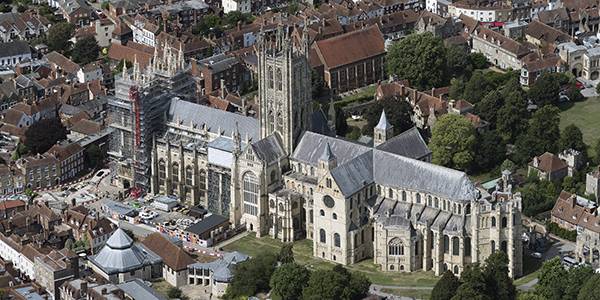
Canterbury. Picture: John Fielding/(CC BY 2.0) licence
With 85 seats and covering nine counties (Hampshire, West and East Sussex, Kent, Buckinghamshire, Oxfordshire, Berkshire, Surrey and the Isle of Wight), the South East is the largest electoral region, and is responsible for nearly a quarter of all Conservative seats in Westminster. In 2017, the Conservatives took 72 of those seats (with one more, Buckingham, electing the then Speaker John Bercow, effectively uncontested, in what is considered a safe Conservative seat). Labour took eight seats, the Lib Dems two, and the Green Party one, their single Westminster seat.
The forecast for 2019 seems at first glance to be one of electoral stability. YouGov’s constituency forecasting has just one seat changing hands, with Eastbourne switching from Lib Dems back to the Conservatives. However, the South East caused some of the biggest upsets in 2017. Both Labour and the Lib Dems made small but significant inroads into the Conservatives’ seat count. Labour gained Brighton Kemptown, Portsmouth South, Reading East and most spectacularly Canterbury from the Conservatives. The Liberal Democrats regained Eastbourne, which they had held until 2015, and Oxford West & Abingdon, last held by them in 2010.
In 2019, there are a couple of pro-Remain former Conservatives standing as Independents plus Lib Dems targeting some of the heavily Remain parts of the commuter belt, which creates some contests worth paying attention to. In a region that UKIP strongly targeted in past elections, and where the Brexit Party gained 36% of the vote and four MEPs in May’s European elections, Farage’s decision for his party not to stand candidates in Conservative-held seats means they are largely insignificant in constituency contests in the South East.
Map of South East 2017 general election results, with key seats labelled
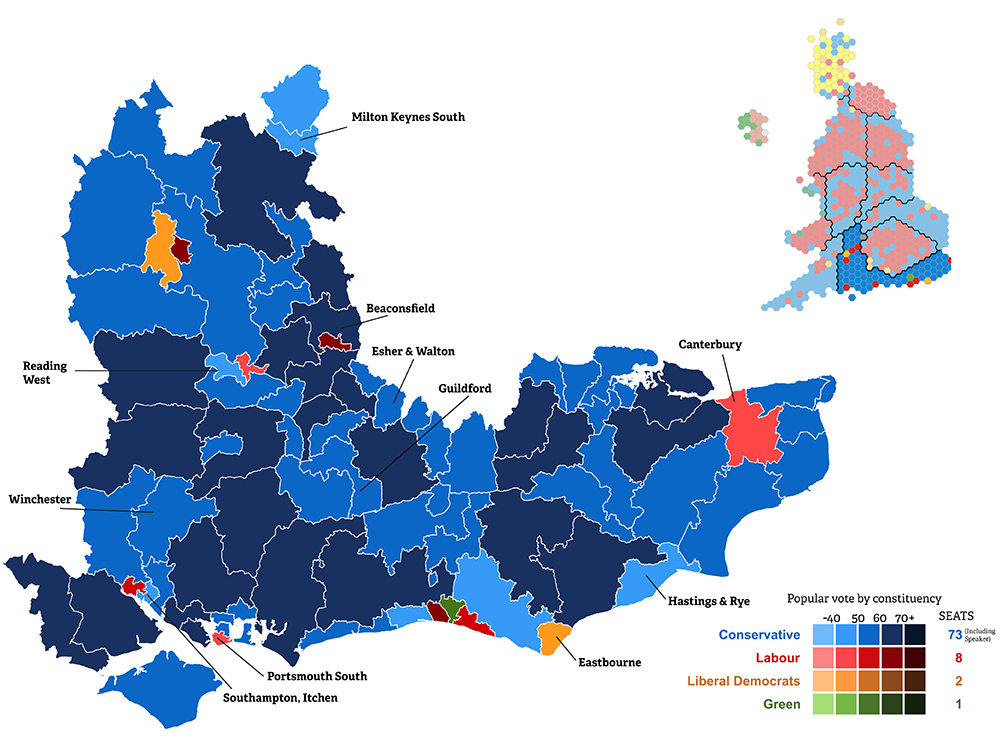
Source: Adapted from map by DrRandomFactor & Ch1902 /Wikipedia. Key constituency contests for 2019 labelled.
For all seats in the region, you can find full details of the candidates standing in 2019 and their social media links at DemocraticDashboard.com. It also gives complete results from the 2017 general election, estimated 2016 EU referendum results and details about the constituency so you can best make up your own mind how to vote.
The estimated constituency results for all seats in the South East in 2019, and regional vote shares given in figures 1 and 2, come from YouGov’s large MRP poll published on 27 November and are the best available at the time of writing. A sample of 100,319 people was polled across the UK, and used, along with demographic and other data, to create estimates for each constituency.
Figure 1: Number of seats won by each party at the last three general elections in the South East, and 2019 estimates from YouGov polling, 27 November
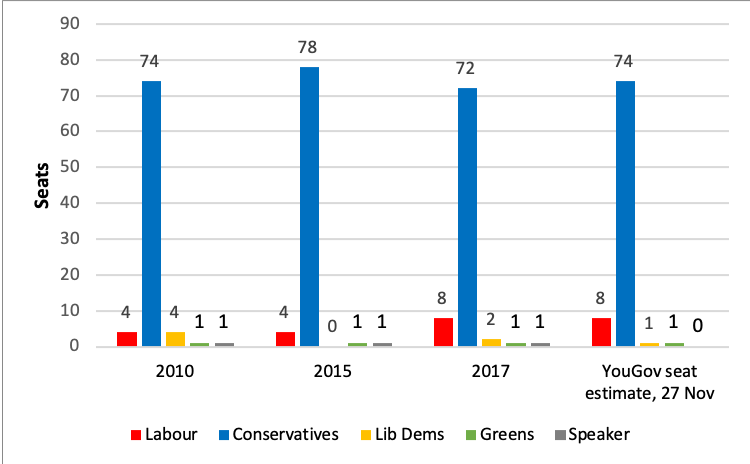
Note: 2019 figures from YouGov MRP seat estimates, 27 November, 2019.
Figure 2: Parties’ shares of the votes in the South East at the last three general elections, and estimated vote shares in YouGov 27 November poll
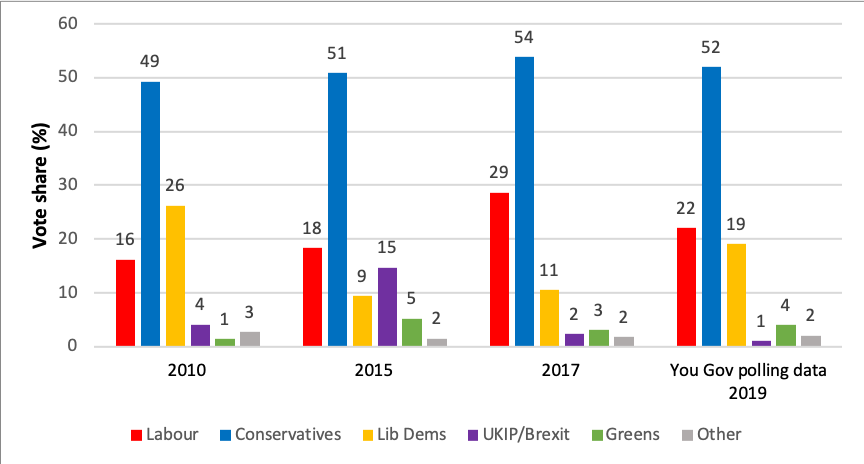
Note: YouGov/MRP data for London from Benjamin Lauderdale and Jack Blumenau for YouGov, 27 Nov national MRP poll.
Seats the Conservative will want to regain
Eastbourne has repeatedly switched between the Lib Dems and Conservatives, ever since the Lib Dems won it in a by-election in 1990. They lost it in 1992, regained it in 2010, only to lose in 2015, and win it back in 2017. It is one of three losses of current seats YouGov forecasts for the party nationwide, with the Conservatives on course to regain the seat. Eastbourne demonstrates the difficulties the Lib Dems could face in retaining seats in Leave-leaning places as they pitch heavily for Remainer votes. The Lib Dem MP here Stephen Lloyd resigned the whip in 2018, so he could fulfil his election pledge to his constituents to vote to implement Brexit, in line with it being a seat where a majority voted to leave (est. 57% Leave vote). He retook the whip for this election, on the grounds he is seeking a new mandate with a new policy. His Conservative opponent is Caroline Ansell, who held the seat between 2015 and 2017.
An unlikely win for Labour in 2017, Canterbury has been much cited as evidence for the swing to Labour in urban, student-heavy Remain areas. Rosie Duffield defends a majority of just 187 votes. The initial Lib Dem candidate for the seat, Tim Walker, stood down so as not to split the Remain vote away from Duffield. His replacement, Claire Malcomson, was added to the nominating papers near the deadline. The Brexit Party has stood down here in favour of the Conservatives. According to YouGov’s forecast, it will remain Labour. Portsmouth South, also won by Labour in 2017, could also see the Conservatives win if their opposition is split between Labour and Lib Dems, but on current polling YouGov estimates that Labour will retain it.
Labour targets
The Conservatives took Southampton, Itchen from Labour in 2015, and retained it by just 31 votes in in 2017, making it the sixth most marginal seat in the UK. With an estimated Leave vote share of 60%, and no Brexit Part candidate, YouGov’s forecast keeps it safely Conservative. However, it does have a significant student population, which is being targeted by Labour, and it is one seat where there is clear evidence of increased voter registration, which could be an indication of some increased advantage for Labour.
Other seats in the South East that are currently very marginal for the Conservatives, and so potentially vulnerable if Labour sees an uptick in their vote share by polling day, include: Hastings and Rye, where former minister Amber Rudd had a majority of just 346 in 2017 and has stood down; both Milton Keynes constituencies, particularly Milton Keynes South, where the majority is 2.6%; and possibly Reading West, though according to an Economist poll right at the start of the campaign, Labour was slipping backwards here.
Liberal Democrat targets
Although the South East overall had a small Leave voting majority (51.8%), there is distinct variation within the region, with commuter-belt parts of Surrey, Oxfordshire and Hampshire containing some strongly Remain constituencies, which are a particular focus for the Lib Dems’ campaign. Although they came second in seven seats in the South East in 2017, for most they would need to achieve some very large swings from the Conservatives to win. Winchester in Hampshire voted 60% Remain, but in 2017 the Conservatives safely held on to it, polling 52% to the Lib Dems’ 35%. However, the Lib Dems held the seat between 1997 and 2010, and the party has maintained its position as second party locally since losing to the Conservatives in 2010. They also took control of the local council after May’s elections. YouGov’s estimate currently puts the Lib Dems just behind the Conservatives on 44% to 47%.
Another close contest on latest polling is Guildford, where in a constituency seat poll over the weekend, the Lib Dems and Tories are neck-and-neck, with the Lib Dems on 41% to the Conservatives’ 40% (more or less in-keeping with the YouGov forecast, which has the Conservatives slightly ahead). The former Conservative MP here is Anne Milton, who had the whip withdrawn for blocking a no-deal Brexit. She, along with several colleagues (discussed below), is standing as an independent, but the constituency poll has her on a just 7%. Remain tactical voting sites are therefore recommending a Lib Dem vote here.
Of the remaining seats where the Lib Dems came second in 2017, Lewes is also one where they could be in contention, though it remains forecast for a Conservative win on latest polling.
The Lib Dems are, however, also pouring resources into some longer-shot seats, buoyed by activist enthusiasm and the prospects of ‘decapitating’ prominent Brexiteer Conservatives. In Esher & Walton, Conservative Foreign Secretary Dominic Raab was returned with a 39% majority in 2017, with Labour second place and Lib Dems third. However, a recent constituency poll put Lib Dem candidate Monica Harding a strong second, just five points behind Raab. It’s a long shot, but she has a strong local campaign and celebrity endorsements. They are also putting up Conservative defector Phillip Lee against arch-Brexiteer John Redwood in Wokingham, but again, though the seat leans Remain, Redwood’s majority is a sizeable 31%, though YouGov estimates this will be slashed to around 10%. Here, as across the South East, the story for the Lib Dems is in all likelihood a strongly improved vote share, and strong second place, but them coming short of winning seats.
Independent candidates
Former Conservative MP and former Attorney General, Dominic Grieve is standing as an Independent in his original seat of Beaconsfield, since having the Tory whip removed for voting against the Johnson government on a no-deal Brexit. He has been MP here since 1997, elected on huge majorities, which makes it a hard task to overturn the Conservative incumbent vote share: Grieve is essentially attempting to overturn his own previous majority of 44%. The seat is fairly evenly split in terms of the Brexit vote, so it must be considered a long shot campaign, given the difficulties independent candidates face in terms of campaign resources. However, he has received high-profile endorsements, including from former Prime Minister John Major, and is the recommended candidate by tactical Remain voting sites. Unlike Milton in Guildford (and David Gauke, also standing as an independent in nearby South West Hertfordshire, in the East of England region), Grieve has the added advantage that the local Lib Dem candidate has withdrawn his candidacy, and the local party is actively campaigning for him. A constituency poll in Beaconsfield put Grieve on 35% to Conservative candidate Joy Morrissey’s 53%.
Important seats for the Green Party
The Greens’ first, and so far only, Westminster seat is Brighton Pavilion, which Caroline Lucas won from Labour in 2010. She has progressively increased her vote share with each election since, making it now a safe seat for them. Their other target in the region, and part of the Unite to Remain alliance, so no Lib Dem is standing, is the Isle of Wight, where they came a strong third on 17% in 2017.
Figure 3: The South East’s most marginal seats (by % vote) from the 2017 election
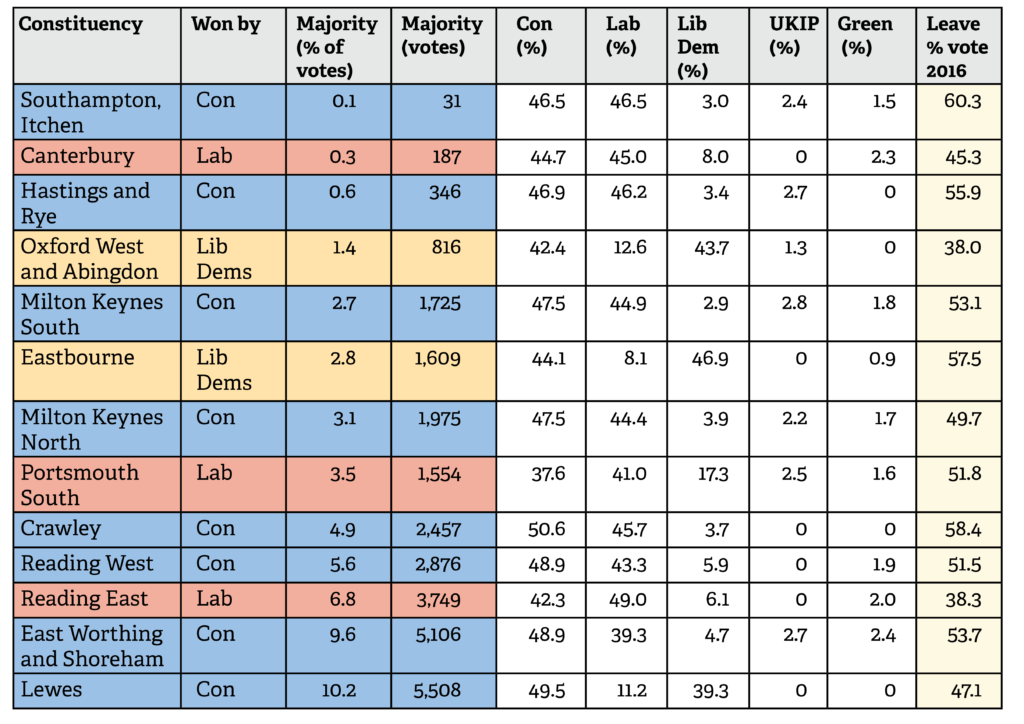
Note: The Leave % for each the 2016 Brexit referendum by constituency (and mentioned throughout this article), are Chris Hanretty’s estimates. You can also find these for each constituency (including those we don’t discuss), along with general election results at DemocraticDashboard.com.





 Democratic Audit's core funding is provided by the Joseph Rowntree Charitable Trust. Additional funding is provided by the London School of Economics.
Democratic Audit's core funding is provided by the Joseph Rowntree Charitable Trust. Additional funding is provided by the London School of Economics.